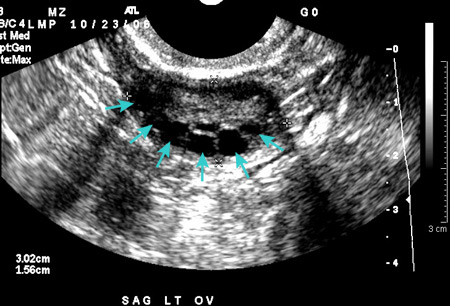Amenorrhoea is the transient or permanent absence of menstrual flow. There is no consensus on the definition of amenorrhoea, but it may be subdivided into primary and secondary amenorrhoea as follows:[1]Practice Committee of the American Society for Reproductive Medicine. Current evaluation of amenorrhea: a committee opinion. Fertil Steril. 2024 Jul;122(1):52-61.
https://www.fertstert.org/article/S0015-0282(24)00082-7/fulltext
http://www.ncbi.nlm.nih.gov/pubmed/38456861?tool=bestpractice.com
Primary amenorrhoea: lack of menses by age 15 years in a patient with appropriate development of secondary sexual characteristics, or lack of menses within 5 years of breast development if breast development occurred before age 10 years
Secondary amenorrhoea: lack of menses for >3 months in a non-pregnant female who previously had regular menstrual cycles, or lack of menses for 6 months in a female who previously had irregular menstrual cycles.
Although attributes overlap between the two groups, the diagnostic approaches vary significantly.
The prevalence of secondary amenorrhoea is estimated to be 3% to 4%; primary amenorrhoea is considerably less common (<0.1%).[2]Timmreck LS, Reindollar RH. Contemporary issues in primary amenorrhea. Obstet Gynecol Clin North Am. 2003 Jun;30(2):287-302.
http://www.ncbi.nlm.nih.gov/pubmed/12836721?tool=bestpractice.com
[3]Pettersson F, Fries H, Nillius SJ. Epidemiology of secondary amenorrhea: incidence and prevalence rates. Am J Obstet Gynecol. 1973 Sep 1;117(1):80-6.
http://www.ncbi.nlm.nih.gov/pubmed/4722382?tool=bestpractice.com
[4]Münster K, Helm P, Schmidt L. Secondary amenorrhoea: prevalence and medical contact--a cross-sectional study from a Danish county. Br J Obstet Gynaecol. 1992 May;99(5):430-3.
http://www.ncbi.nlm.nih.gov/pubmed/1622918?tool=bestpractice.com
Prevalence of secondary amenorrhoea appears to be higher among women who participate in physically demanding sports or disciplines, including cycling (56%), triathlon (40%), rhythmic gymnastics (31%), and ballet (20% to 23%).[5]Gimunová M, Paulínyová A, Bernaciková M, et al. The prevalence of menstrual cycle disorders in female athletes from different sports disciplines: a rapid review. Int J Environ Res Public Health. 2022 Oct 31;19(21):14243.
https://pmc.ncbi.nlm.nih.gov/articles/PMC9658102
http://www.ncbi.nlm.nih.gov/pubmed/36361122?tool=bestpractice.com
[6]Stokić E, Srdić B, Barak O. Body mass index, body fat mass and the occurrence of amenorrhea in ballet dancers. Gynecol Endocrinol. 2005 Apr;20(4):195-9.
http://www.ncbi.nlm.nih.gov/pubmed/16019361?tool=bestpractice.com
[7]Bacchi E, Spiazzi G, Zendrini G, et al. Low body weight and menstrual dysfunction are common findings in both elite and amateur ballet dancers. J Endocrinol Invest. 2013 May;36(5):343-6.
http://www.ncbi.nlm.nih.gov/pubmed/23027765?tool=bestpractice.com
Evidence regarding the incidence and prevalence of amenorrhoea is, however, scarce.
The most common causes include polycystic ovary syndrome, hypothalamic dysfunction, premature ovarian failure, and hyperprolactinaemia.[8]Polycystic ovary syndrome and secondary amenorrhoea. In: Edmonds K, ed. Dewhurst's textbook of obstetrics and gynaecology. 9th edition. Chichester: Wiley-Blackwell; 2018:513-33.
Although there are many causes of secondary amenorrhoea, the incidence of each aetiology is low. In general, amenorrhoea accounts for a relatively small percentage of patient visits, even at highly specialised centres.
Despite the low prevalence of secondary amenorrhoea, a prompt, comprehensive assessment is warranted unless the patient is pregnant, lactating, or using hormonal contraceptives, as amenorrhoea is often the presenting sign of an underlying reproductive disorder. A delay in diagnosis and treatment may adversely impact the future of such patients. For example, in polycystic ovary syndrome and hyperinsulinaemia, behavioural and dietary modifications may prevent subsequent cardiovascular disease.


Log in or subscribe to access all of BMJ Best Practice